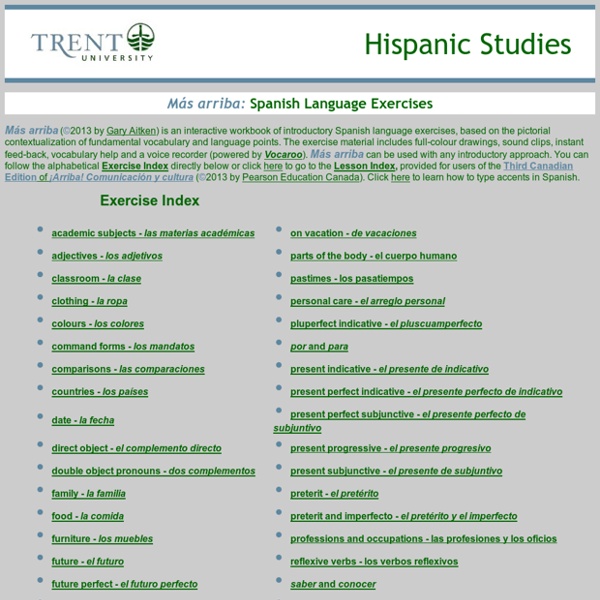Coffee Break Spanish
Join millions of Spanish learners from all around the world and learn Spanish with Coffee Break Spanish. This course has consistently been among the top language-learning podcasts in iTunes US and UK and won the European Award for Languages in 2007 and the European Professional Podcast Award in 2009. Teacher Mark brings his experience of teaching the language to each show, and listeners can learn alongside student Kara. Visit our lesson library where you can access free audio files to get a taste of the course. Comprehensive support materials are available in our bonus season passes.
Languages Resources Spanish
The Languages Resources Website Spanish AS Level Resources AS Exam Specific
Spanish Language & Culture
Home Activities: Adjectives & Nouns Adverbs Articles Command Forms Comparisons Conditional Tense Demonstrative Adjectives Future Tense Gustar Verbs like Gustar Interrogative Words Negative/Affirmative Words Numbers Past Participle Perfect Tenses Por vs Para Prepositions with qtvr movie Present Participle (gerund) Present Progressive Tense Present Tense Preterite Tense Preterites w/ Irregular Meanings Preterite vs Imperfect Pronouns DO Pronouns IO Pronunciation Reflexive Verbs Relative Pronouns Saber vs Conocer Ser vs Estar Sequence of Tenses Si Clauses Subjunctive Mood (present) Subjunctive mood (past) Time-¿Qué hora es? Tener-idiomatic expressions Unplanned events with SE Verb conjugation charts: Present tense Preterite tense Present subjunctive Imperfect subjunctive
morning glory
To awaken with a boner so hard a cat couldn't scratch it , otherwise known as to sleep in a tent, or to have a dawn horn. Loose the morning glory before you put somebody's eye out by oxmix October 21, 2003 Photos & Videos When you wake up with morning wood, put it in your girlfriends ass and yell "the south will rise again!"
Spanish Pronouns
A Pronoun in Spanish as well as in English is like a shortcut to refer to a noun, a word that stands for or represents a noun or noun phrase, a pronoun is identified only in the context of the sentence in which they are used. So you must have a prior idea about who "he or she" "él or ella" is. In English we find "me, her, what, that, his", In Spanish they're used pretty much the same way, the main difference is that in Spanish most pronouns have a gender, masculine or feminine and rarely neuter to unknown objects or ideas. Types of pronouns include personal pronouns (refer to the persons speaking, the persons spoken to, or the persons or things spoken about), indefinite pronouns, relative pronouns (connect parts of sentences) and reciprocal or reflexive pronouns (in which the object of a verb is being acted on by verb's subject). This table below shows examples of all pronouns categories in Spanish:
Spanish Language & Culture
Home Activities: Adjectives & Nouns Adverbs Articles Command Forms Comparisons Conditional Tense Demonstrative Adjectives Future Tense Gustar Verbs like Gustar Interrogative Words Negative/Affirmative Words Numbers Past Participle Perfect Tenses Por vs Para Prepositions with qtvr movie Present Participle (gerund) Present Progressive Tense Present Tense Preterite Tense Preterites w/ Irregular Meanings Preterite vs Imperfect Pronouns DO Pronouns IO Pronunciation Reflexive Verbs Relative Pronouns Saber vs Conocer Ser vs Estar Sequence of Tenses Si Clauses Subjunctive Mood (present) Subjunctive mood (past) Time-¿Qué hora es? Tener-idiomatic expressions Unplanned events with SE
Learn Spanish with these Resources
To learn Arabic, you’re going need a way to learn correct pronunciation and the alphabet, a frequency dictionary to form your base vocabulary, and a good grammar book. You’ll also benefit from a thematic vocabulary book for specialized vocabulary and maybe a book or two, once you learn your first 1000 words. Make sure you read the Method sections of the website, then check out some of these recommended resources (pictures are links): Alphabet and Pronunciation Note: As a faster (and more effective) alternative to the following pronunciation resources, check out my Kickstarter project. It will make the first steps of Arabic much easier for you, because it takes advantage of how your brain works (and how to re-wire it) in a way that traditional tools just can’t.



